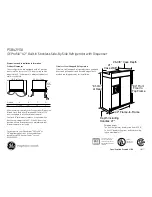
7–29
T-340
3. Disconnect the battery wires from the “KA” plug positions 14, 13, 11.
4. Using Driver Bit, Carrier Transicold part number 07-00418-00, remove the 4 screws securing the display
module to the control box. Disconnect the ribbon cable and set the display module aside.
NOTE
The battery wires must face toward the right.
5. Remove the old battery from the bracket and clean bracket surface. Remove the protective backing from the
new battery and assemble to the bracket. Secure battery by inserting the wire tie from the back of the
bracket around the battery, and back through the bracket.
6. Reconnect the ribbon cable to display and re- install the display.
7. Route the battery wires from the battery along the display harness and connect the red battery wire and one
end of the red jumper to “KA14,” the other end of the red jumper wire to “KA11,” and the black wire to
“KA13.”
8. Replace wire ties that were removed.
7.24 Temperature Sensor Service
Service procedures for the return recorder, return temperature, supply recorder, supply temperature, ambient,
defrost temperature, evaporator temperature, and compressor discharge temperature sensors are provided here.
7.24.1
Sensor Checkout Procedure
This procedure is performed to verify the accuracy of a temperature sensor:
1. Remove the sensor and place in a 0°C (32°F) ice-water bath. The ice-water bath is prepared by filling an
insulated container (of sufficient size to completely immerse bulb) with ice cubes or chipped ice, then filling
voids between ice with water and agitating until mixture reaches 0°C (32°F) measured on a laboratory ther
-
mometer.
2. Start unit and check sensor reading on the control panel. The reading should be 0°C (32°F). If the reading is
correct, reinstall sensor; if it is not, continue with the following.
3. Turn unit OFF and disconnect power supply.
4. See
and remove controller to gain access to the sensor plugs.
5. Using the plug connector marked “EC” that is connected to the back of the controller, locate the sensor
wires (RRS, RTS, SRS, STS, AMBS, DTS, or CPDS as required). Follow those wires to the connector and
using the pins of the plug, measure the resistance. Values are provided in
.
Due to the variations and inaccuracies in ohmmeters, thermometers or other test equipment, a reading
within 2% of the chart value would indicate a good sensor. If a sensor is defective, the resistance reading will
usually be much higher or lower than the resistance values given.
















































